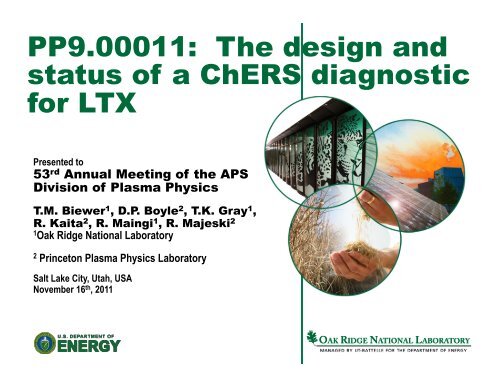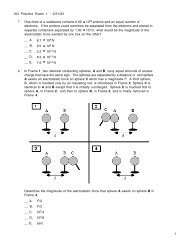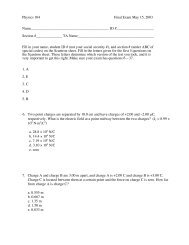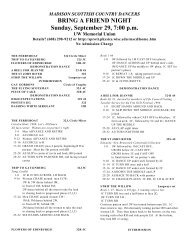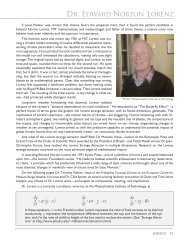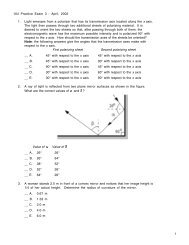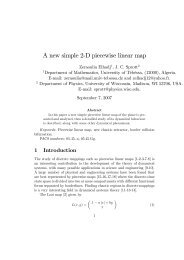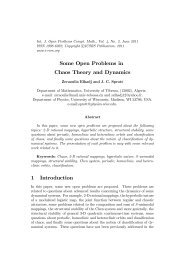2011 APS DPP Poster
2011 APS DPP Poster
2011 APS DPP Poster
Create successful ePaper yourself
Turn your PDF publications into a flip-book with our unique Google optimized e-Paper software.
PP9.00011: The design and<br />
status of a ChERS diagnostic<br />
for LTX<br />
Presented to<br />
53 rd Annual Meeting of the <strong>APS</strong><br />
Division of Plasma Physics<br />
T.M. Biewer 1 , D.P. Boyle 2 , T.K. Gray 1 ,<br />
R. Kaita 2 , R. Maingi 1 , R. Majeski 2<br />
1 Oak Ridge National Laboratory<br />
2 Princeton Plasma Physics Laboratory<br />
Salt Lake City, Utah, USA<br />
November 16 th , <strong>2011</strong>
Abstract<br />
There has been a long-standing collaboration between ORNL and PPPL in the area of<br />
edge and boundary layer plasma physics. As part of this collaboration, ORNL has a<br />
large role in the instrumentation and interpretation of the edge physics in the Lithium<br />
Tokamak Experiment (LTX). In particular, a charge-exchange recombination<br />
spectroscopy (ChERS) diagnostic is being designed and is undergoing a staged<br />
implementation on LTX. This year passive spectroscopy measurements have been<br />
made on LTX, in anticipation of active spectroscopy measurements, which will be<br />
enabled by the installation of a diagnostic neutral beam in 2012. The LTX ChERS<br />
diagnostic will consist of both toroidal and poloidal lines of sight, allowing for profile<br />
measurements of all the plasma parameters (T i , n Li , v P , v T ) required for the calculation<br />
via force balance of the radial electric field profile (E r ), when combined with the<br />
magnetic field profile from equilibrium reconstructions. The effect of lithium on the E r<br />
profile, as well as the fundamental plasma parameters, is a major topic of interest for<br />
LTX and the plasma physics community. Preliminary data will be presented.<br />
This work was supported by the US. D.O.E. contracts DE-AC05-00OR22725 and DE-<br />
AC02-09CH11466.<br />
2 Managed by UT-Battelle<br />
for the U.S. Department of Energy<br />
T.M. Biewer, 53 rd <strong>APS</strong> <strong>DPP</strong> Mtg., Salt Lake City, Nov. 16 th <strong>2011</strong>
Staged Implementation Strategy<br />
• Proposal awarded for 3 years of effort<br />
• FY<strong>2011</strong>: Passive Spectroscopy<br />
– Install temporary optics and utilize available equipment to<br />
make preliminary measurements<br />
• FY2012: Active Spectroscopy<br />
– Design and install optics in conjunction with the installation<br />
of the neutral beam injection (NBI) system<br />
• FY2013: Optimization and Physics Exploration<br />
– Purchase and install dedicated hardware for an LTX-optimized<br />
ChERS diagnostic<br />
3 Managed by UT-Battelle<br />
for the U.S. Department of Energy<br />
T.M. Biewer, 53 rd <strong>APS</strong> <strong>DPP</strong> Mtg., Salt Lake City, Nov. 16 th <strong>2011</strong><br />
Main subject of this <strong>Poster</strong>.
Short Focal Length Spectrometer<br />
4 Managed by UT-Battelle<br />
for the U.S. Department of Energy<br />
T.M. Biewer, 53 rd <strong>APS</strong> <strong>DPP</strong> Mtg., Salt Lake City, Nov. 16 th <strong>2011</strong><br />
• Kaiser Optical Holospec f/1.8<br />
– Fixed “HD” grating<br />
– Curved entrance slits<br />
• mounting plates<br />
• Fiberbundle: 17 channel SMA bundle for HD<br />
– 600 µm PCS (100 °C), 7 m<br />
• Configuration with above:<br />
– 10 views: 85 mm exit lens<br />
– 15 views: 58 mm exit lens<br />
– 17 views: 50 mm exit lens<br />
– More views = lower resolution<br />
• BP filter and new bundle can 2x or 3x views<br />
(at ½ or 1/3 of the wavelength coverage)<br />
• CCD camera<br />
Ref: R.E. Bell, Rev. Sci. Inst. 75(10): 4 (2004).<br />
– Buy: EMCCD ~$35k or sCMOS ~$20k?
Example Multi-chord Viewing Optics<br />
5 Managed by UT-Battelle<br />
for the U.S. Department of Energy<br />
T.M. Biewer, 53 rd <strong>APS</strong> <strong>DPP</strong> Mtg., Salt Lake City, Nov. 16 th <strong>2011</strong><br />
• Collimating (fused silica) lens<br />
attaches to fiber (SMA mount).<br />
– f=10 mm, d=5mm: f/2 acromat<br />
– Ocean Optics 74-ACR<br />
• Pucks positioned at multiple<br />
locations with mounting collars.<br />
• Designed to fit standard size vacuum<br />
windows: 2-3/4”, 4-5/8”, 6”, . . .<br />
• Note: windows need to have cap<br />
head bolts, NOT hex-head.
Sightline Layout for Passive Spectroscopy<br />
6” tangential port<br />
6 l.o.s., -0.15
2 ¾” Puck Detail for Poloidal L.o.S.<br />
7 Managed by UT-Battelle<br />
for the U.S. Department of Energy<br />
T.M. Biewer, 53 rd <strong>APS</strong> <strong>DPP</strong> Mtg., Salt Lake City, Nov. 16 th <strong>2011</strong><br />
• Original “straight down” concept can be<br />
improved by angling outer views<br />
– Reduce vignetting<br />
– Expand radial range<br />
– “Straight” r/a: -0.16, -0.22, -0.28<br />
– “Angled” r/a: 0.02, -0.22, -0.46
4 5/8” Puck Detail for Poloidal L.o.S.<br />
8 Managed by UT-Battelle<br />
for the U.S. Department of Energy<br />
T.M. Biewer, 53 rd <strong>APS</strong> <strong>DPP</strong> Mtg., Salt Lake City, Nov. 16 th <strong>2011</strong><br />
• This port is over a “chimney” in<br />
the shell.<br />
• Large stand-off between window<br />
and chimney means little<br />
advantage to “angling” l-o-s.<br />
• Vignetting of outer 2 l-o-s.<br />
• r/a: 0.06, 0.12, 0.17, 0.23, 0.29
6” Puck Detail for Toroidal L.o.S.<br />
• Original “straight through” concept has sightlines inboard of<br />
magnetic axis; difficult to invert passive data<br />
– “Straight” r/a: -0.15, -0.20, -0.26,-0.32, -0.37, -0.43, -0.49<br />
• Radial coverage shifted to outboard side by angling views<br />
– “Angled” r/a: -0.11, 0, 0.11, 0.27, 0.37, 0.48<br />
9 Managed by UT-Battelle<br />
for the U.S. Department of Energy<br />
T.M. Biewer, 53 rd <strong>APS</strong> <strong>DPP</strong> Mtg., Salt Lake City, Nov. 16 th <strong>2011</strong>
Passive Spectroscopy Sightline Summary<br />
• 2 ¾” port pair:<br />
– 3 poloidal sightline pairs<br />
• r/a: ~0, -0.22, ~-0.46<br />
• 4 5/8” port pair:<br />
– 5 poloidal sightline pairs<br />
• r/a: 0.06, 0.12, 0.17, 0.23, 0.29<br />
• 6” tangential port w/ gate valve:<br />
– 6 toroidal sightlines<br />
• r/a: -0.11, 0.0, 0.11, 0.27, 0.37, 0.48<br />
• Toroidal and Poloidal coverage from 0
Equipment List and Cost Estimate<br />
• Collection optics<br />
– Pucks & collars: ~$2k<br />
– Acromat lenses: ~$2.2k<br />
• Fiberbundle: borrow from ORNL (~$4k)<br />
• Spectrometer and detector<br />
– Slits (75, 150, 250 microns): borrow from ORNL (~$3k)<br />
– Spectrometer: borrow from ORNL (~$6.4k)<br />
– Gratings: borrow from ORNL, PPPL (NSTX) (~$5.7k ea.)<br />
– Output lens (85 mm= 10 channels): borrow from ORNL (
Passive Spectroscopy Simulations<br />
• Code written to simulate (for a given set of Li 2+ n i , T i ,<br />
v T profiles), what the measured passive spectra for<br />
this spectrometer/camera should look like.<br />
• Additional code fits Gaussian distributions to this<br />
“data” to give l.o.s. estimations of the Li n i , T i , v T<br />
profiles.<br />
• These “measurements” are inverted to yield local<br />
values of Li n i , T i , v T (which can be compared to the<br />
given profiles.)<br />
– R.E. Bell, Rev. Sci. Instrum. 68 (2) 1997, p. 1273.<br />
12 Managed by UT-Battelle<br />
for the U.S. Department of Energy<br />
T.M. Biewer, 53 rd <strong>APS</strong> <strong>DPP</strong> Mtg., Salt Lake City, Nov. 16 th <strong>2011</strong>
Example 1” Resolution Array, 8 L.o.S.<br />
n i is well reconstructed<br />
v T is pretty good!<br />
13 Managed by UT-Battelle<br />
for the U.S. Department of Energy<br />
T.M. Biewer, 53 rd <strong>APS</strong> <strong>DPP</strong> Mtg., Salt Lake City, Nov. 16 th <strong>2011</strong><br />
T i is accurately inverted,<br />
but large error bars<br />
Black=given profile<br />
Red=l.o.s. measurement<br />
Green=inversion calculation
Example 1” Resolution Array is OK<br />
Even if n Li is Hollow.<br />
14 Managed by UT-Battelle<br />
for the U.S. Department of Energy<br />
T.M. Biewer, 53 rd <strong>APS</strong> <strong>DPP</strong> Mtg., Salt Lake City, Nov. 16 th <strong>2011</strong><br />
Black=given profile<br />
Red=l.o.s. measurement<br />
Green=inversion calculation
“As Built” Array with Peaked n Li Profile<br />
15 Managed by UT-Battelle<br />
for the U.S. Department of Energy<br />
T.M. Biewer, 53 rd <strong>APS</strong> <strong>DPP</strong> Mtg., Salt Lake City, Nov. 16 th <strong>2011</strong><br />
Black=given profile<br />
Red=l.o.s. measurement<br />
Green=inversion calculation<br />
Lack of edge<br />
data leads to<br />
large error bar<br />
and inaccuracy<br />
on outer-most<br />
chord.<br />
(75 micron<br />
instrument<br />
function)
“As Built” Array with Flat n Li Profile<br />
16 Managed by UT-Battelle<br />
for the U.S. Department of Energy<br />
T.M. Biewer, 53 rd <strong>APS</strong> <strong>DPP</strong> Mtg., Salt Lake City, Nov. 16 th <strong>2011</strong><br />
Black=given profile<br />
Red=l.o.s. measurement<br />
Green=inversion calculation<br />
Lack of edge data<br />
leads to large error<br />
bar and inaccuracy<br />
on outer-most chord.<br />
Flat n i profile causes<br />
difficulty for inversion<br />
routine.<br />
(75 micron<br />
instrument function)
“As Built” Array with Hollow n Li Profile<br />
17 Managed by UT-Battelle<br />
for the U.S. Department of Energy<br />
T.M. Biewer, 53 rd <strong>APS</strong> <strong>DPP</strong> Mtg., Salt Lake City, Nov. 16 th <strong>2011</strong><br />
Black=given profile<br />
Red=l.o.s. measurement<br />
Green=inversion calculation<br />
Lack of edge<br />
data leads to<br />
large error bar<br />
and inaccuracy<br />
on most chords.<br />
Hollow n i makes<br />
core T i and v T<br />
measurements<br />
problematic.<br />
(75 micron<br />
instrument<br />
function)
Passive Spectroscopy Simulation<br />
Summary<br />
• Simulations of the “as built” toroidal array suggest that the<br />
inversion of line-of-sight passive spectroscopy data can be<br />
accomplished to yield local values of Li III emissivity, T i , and v T .<br />
– Greatest accuracy of the inversion is achieved when the brightness of Li III emission<br />
is centrally peaked.<br />
– Hollow Li III emission can not easily be inverted for the “as built” array.<br />
– Qualitative information about the Li III brightness profile shape can be inferred.<br />
• Increasing the number of lines-of-sight improves the inversion<br />
accuracy, especially with the addition of edge chords.<br />
• If the installation of the Neutral Beam Injector (NBI) is greatly<br />
delayed, then a more comprehensive passive spectroscopy array<br />
could be justified.<br />
18 Managed by UT-Battelle<br />
for the U.S. Department of Energy<br />
T.M. Biewer, 53 rd <strong>APS</strong> <strong>DPP</strong> Mtg., Salt Lake City, Nov. 16 th <strong>2011</strong>
Passive Spectroscopy Measurements<br />
• Collection optics installed and back-illuminated: July <strong>2011</strong><br />
– Need to double-check optics pointing against engineering model<br />
• Spectrometer/CCD installed: Sept. <strong>2011</strong><br />
– Wavelength calibrated ex-vessel with neon lamp and absoluteintensity<br />
light source<br />
• LTX vessel-filling neon glow: Nov. <strong>2011</strong><br />
– Cross check of wavelength calibration<br />
– Instrument function for extant optical path<br />
– Vacuum window transmission estimation (with assumptions)<br />
• LTX plasma discharge data collected (1 week ago)<br />
– Preliminary results shown below<br />
19 Managed by UT-Battelle<br />
for the U.S. Department of Energy<br />
T.M. Biewer, 53 rd <strong>APS</strong> <strong>DPP</strong> Mtg., Salt Lake City, Nov. 16 th <strong>2011</strong>
Hardware Installed on LTX (Sept. <strong>2011</strong>)<br />
20 Managed by UT-Battelle<br />
for the U.S. Department of Energy<br />
T.M. Biewer, 53 rd <strong>APS</strong> <strong>DPP</strong> Mtg., Salt Lake City, Nov. 16 th <strong>2011</strong>
Calibration of Spectrometer/CCD<br />
21 Managed by UT-Battelle<br />
for the U.S. Department of Energy<br />
T.M. Biewer, 53 rd <strong>APS</strong> <strong>DPP</strong> Mtg., Salt Lake City, Nov. 16 th <strong>2011</strong>
Calibrated Light Source<br />
• Ocean Optics HL-2000 calibration “white” light source<br />
used on each track<br />
• Does not include transmission factors of vacuum<br />
window, lenses, and/or obstructions<br />
22 Managed by UT-Battelle<br />
for the U.S. Department of Energy<br />
T.M. Biewer, 53 rd <strong>APS</strong> <strong>DPP</strong> Mtg., Salt Lake City, Nov. 16 th <strong>2011</strong>
Vessel-Filling Neon Glow Calibration<br />
• Wavelength calibration well<br />
preserved (2 months later)<br />
23 Managed by UT-Battelle<br />
for the U.S. Department of Energy<br />
T.M. Biewer, 53rd <strong>APS</strong> <strong>DPP</strong> Mtg., Salt Lake City, Nov. 16th Unidentified line observed in glow, consistent with Fe I<br />
<strong>2011</strong><br />
• Relative intensities of Ne lines<br />
differ between lamp, glow, & NIST<br />
• Transmission variation of vacuum<br />
window and/or obstructions<br />
(assuming uniform glow).<br />
– resolve prior to data inversions!<br />
Caveat: need to apply ex-vessel efficiency and path length differences!<br />
Toroidal l.o.s. Poloidal l.o.s.<br />
Why this<br />
drop?<br />
Vignetting expected<br />
from backlighting<br />
edge-most core-most edge-most core-most
Preliminary Data from LTX Pulses<br />
Saturation<br />
CCD framing period<br />
2.25 ms<br />
C II 5133 Å<br />
Li III 5167 Å<br />
Li III 5167 Å<br />
“CHERS line”<br />
LTX plasma:<br />
~40 kA, ~15 ms<br />
24 Managed by UT-Battelle<br />
for the U.S. Department of Energy<br />
T.M. Biewer, 53 rd <strong>APS</strong> <strong>DPP</strong> Mtg., Salt Lake City, Nov. 16 th <strong>2011</strong><br />
Black = meas. data<br />
Red = Gaussian fit<br />
Evolution of Li III<br />
and Fe I lines<br />
through LTX pulse.
Line-Integrated LTX (Li III 5167) Profiles<br />
Black = toroidal data<br />
Red = poloidal data<br />
Caveat: need to apply ex-vessel and<br />
in-vessel efficiency and path length<br />
differences to enable inversions!<br />
• Li III brightness qualitatively flat or central peaked.<br />
• T i (r) ~ 30 eV, “flat”<br />
• v T (r)~ 0, “flat”<br />
l.o.s. toroidal velocity<br />
• v P increasing linear with r/a: ω P (r) ~ 750 krad/s<br />
25 Managed by UT-Battelle<br />
for the U.S. Department of Energy<br />
T.M. Biewer, 53 rd <strong>APS</strong> <strong>DPP</strong> Mtg., Salt Lake City, Nov. 16 th <strong>2011</strong><br />
Li III ion temperature<br />
ω P =750 krad/s<br />
l.o.s. poloidal velocity<br />
Fe I 5165 Å<br />
Li III 5167 Å<br />
• This data is ~1 week<br />
old: preliminary<br />
analysis!<br />
– Line-integrated, plotted<br />
against r/a of sightline<br />
tangency.<br />
– Must be inverted to get<br />
“local” values.<br />
Intensity<br />
FWHM<br />
l.o.s. toroidal velocity<br />
T i
Status of Active Spectroscopy Design<br />
• ChERS design relies heavily on the amount of active<br />
emission of Li III in LTX, which depends on n e , T e , n Li .<br />
– Have measured passive Li III emission in LTX<br />
– Need calculation to estimate active Li III emission at NBI ion<br />
energy (20 - 40 keV)<br />
• Determine collection optics positions (toroidal and<br />
poloidal l.o.s.).<br />
• Tailor CCD/spectrometer/fiberbundle combination.<br />
• Critical item is the delivery of the NBI.<br />
– Estimate 2012<br />
26 Managed by UT-Battelle<br />
for the U.S. Department of Energy<br />
T.M. Biewer, 53 rd <strong>APS</strong> <strong>DPP</strong> Mtg., Salt Lake City, Nov. 16 th <strong>2011</strong>
Summary and Conclusions<br />
• Staged implementation of ChERS diagnostic on LTX: initial passive spectroscopy<br />
measurements presented here.<br />
• Hardware installed on LTX in Sept. <strong>2011</strong>.<br />
– Radial coverage from r/a < 0.5<br />
– 6 toroidal chords, 5-8 matched pair poloidal chords<br />
– Time resolution ~2 ms (LTX pulse length ~>20 ms)<br />
• Spectral simulations suggest this configuration is sufficient to distinguish<br />
qualitative line-integrated profile effects.<br />
– May be possible to invert the data to achieve “local” values from passive emission.<br />
• Preliminary data (from last week) suggests:<br />
– C II light dominates the measured spectra for this instrument<br />
– Fe I is observed in glow and discharge plasma (contamination from vessel liner?)<br />
– Li III (5167 Å) is measurable in LTX, increasing through the discharge<br />
– T i ~ 30 eV, v T ~ 0 km/s, ω P ~ 750 krad/s<br />
• Active spectroscopy (ChERS) planned for 2012.<br />
27 Managed by UT-Battelle<br />
for the U.S. Department of Energy<br />
T.M. Biewer, 53 rd <strong>APS</strong> <strong>DPP</strong> Mtg., Salt Lake City, Nov. 16 th <strong>2011</strong>
Reprints<br />
• Copies of this poster are available online:<br />
– http://sprott.physics.wisc.edu/biewer/<strong>APS</strong><strong>2011</strong>poster.pdf<br />
• Or, write your name and email address below:<br />
28 Managed by UT-Battelle<br />
for the U.S. Department of Energy<br />
T.M. Biewer, 53 rd <strong>APS</strong> <strong>DPP</strong> Mtg., Salt Lake City, Nov. 16 th <strong>2011</strong>
Lines of Sight Projections<br />
LTX axis<br />
29 Managed by UT-Battelle<br />
for the U.S. Department of Energy<br />
2 3/4” port<br />
T.M. Biewer, 53 rd <strong>APS</strong> <strong>DPP</strong> Mtg., Salt Lake City, Nov. 16 th <strong>2011</strong><br />
4 5/8” port<br />
Magnetic axis<br />
Poloidal l.o.s.<br />
Toroidal l.o.s.
ProEM (EMCCD) v. Neo (sCMOS) Cameras<br />
• Andor webinar on 1/20/11 detailing Neo sCMOS camera<br />
– A new technology that we should consider if we have the photons.<br />
• Higher resolution<br />
• Large FOV<br />
– ~30 channels/slit<br />
• ~$15k cheaper<br />
• Larger read noise<br />
– ~100x worse<br />
• ~same speed<br />
~iERD<br />
30 Managed by UT-Battelle<br />
for the U.S. Department of Energy<br />
T.M. Biewer, 53 rd <strong>APS</strong> <strong>DPP</strong> Mtg., Salt Lake City, Nov. 16 th <strong>2011</strong><br />
7c<br />
Modified Figure 6 from LTX CHERS proposal<br />
Neo w/f=58mm<br />
7a<br />
7b


